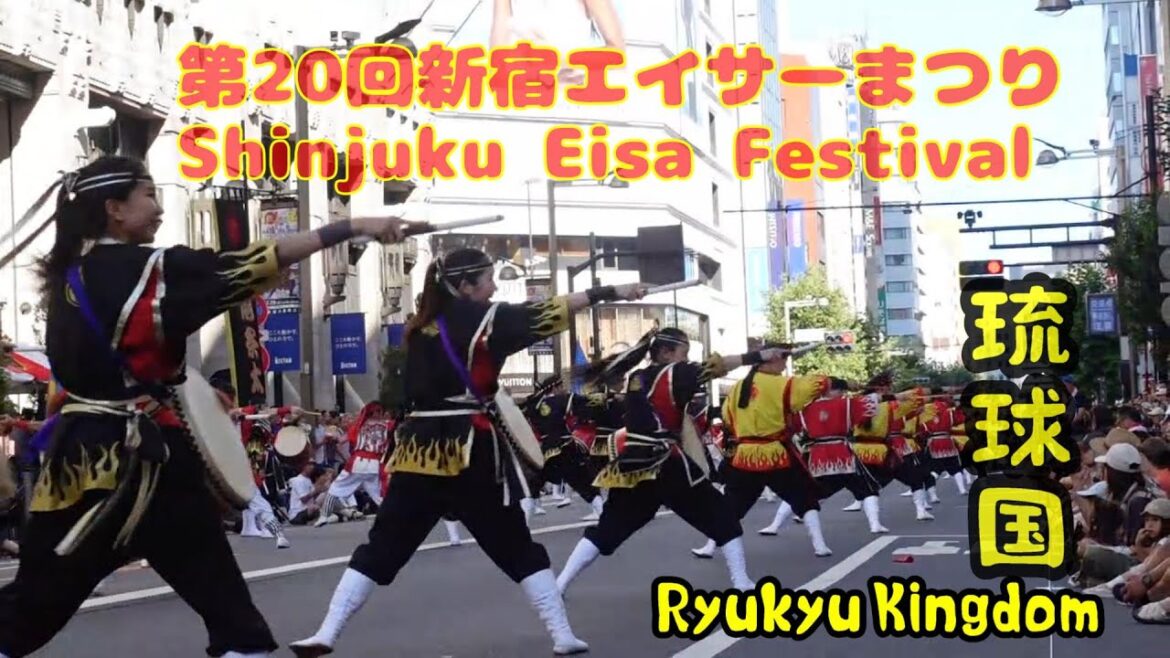Eisa (Okinawan: エイサー, Eisaa) is a form of folk dance originating from the Okinawa Islands, Japan. In origin, it is a Bon dance that is performed by young people of each community during the Bon festival to honor the spirits of their ancestors. It underwent drastic changes in the 20th century and is today seen as a vitalpart of Okinawan culture.
Modern Eisa is danced by 20 to 30 young men and women, mainly in doubled lines or circles to the accompaniment of singing, chanting, and drumming by the dancers as well as by folk songs played on the sanshin. Three types of drums are used in various combinations, depending upon regional style: the ōdaiko (大太鼓), a large barrel drum; the shimedaiko (締太鼓), a medium-sized drum similar to ones used in Noh theatre; and the paarankuu (Okinawan: パーランクー), a small hand drum similar to ones used in Buddhist ceremony. The dancers also sometimes play small hand gongs and yotsutake castanets. Eisa dancers wear various costumes, usually according to local tradition and gender of the dancer; modern costumes are often brightly colored and feature a characteristic, colorful knotted turban. Special vests, leggings, and shoes are also popular.
The origin of Eisa is unclear, like for many other folk performing arts. Iha Fuyū argued that the name of Eisa was related to wesa omoro (Okinawan: ゑさおもろ), a phrase appearing in Volume 14 of the Omoro Sōshi (16th–17th centuries). This theory is no longer supported. It is more likely that the name derived from an exclamation used in the original song of Eisa, the Mamauya Ninbuchi (Okinawan: 継親念仏). The standardization of the written form was relatively new. Meiji era newspaper articles used various forms including yensaa (イェンサー), yaisaa (ヤイサー), and ensaa (エンサー).
The core of Eisa consists of nembutsu songs. The Ryūkyū-koku yuraiki (1713) attributes the introduction of nembutsu to Taichū (1552–1639), a Jōdo sect monk from Mutsu Province. According to the record, he translated Buddhist teaching into the vernacular speech and taught it to the people of Naha during the reign of Shō Nei. Other sources confirm that Taichū stayed in the capital region for three years in the early 1600s and converted the king and other high-ranking officials.Some researchers speculate that he introduced odori nembutsu or dancing nembutsu to Naha. However, Taichū’s teaching did not prevail; it was barely carried on by his followers in Kakinohana, Naha.
Another important factor related to the origin of Eisa is Chondaraa (チョンダラー), a group of puppeteers. The Ryūkyū-koku yuraiki records two theories regarding the etymology of Chondaraa. One is that it indicates their origin, Kyoto. The other is that its founder was named Kyō (no) Kotarō (京小太郎). The fact that their origin had been obscured by the early 18th century suggests that they came from mainland Japan a long time ago. Based on modern-day Shuri Kubagawa-chō (part of the capital Shuri), they performed puppet plays, chanted Banzei (manzai) on celebratory occasions and sang nembutsu songs as a funeral service. For these reasons, they were also called Ninbuchaa (nembutsu prayer) or Yanzayaa (banzei chanter). It is uncertain if the Chondaraa performed nembutsu from the very beginning or learned later from a different group. Unlike Taichū’s followers, they wandered around Okinawa Island.
The spread of nembutsu from mainland Japan was not limited to Okinawa. In the Yaeyama Islands, Bon dance is usually called Angama and is accompanied with nembutsu songs. The Amami Islands also have nembutsu songs, but at least some of them may belong to a tradition different from Okinawa’s Chondaraa.Note that these traditions are not identified with Eisa. Eisa is considered specific to the Okinawa Islands.
エイサーとは、旧盆の最終日(旧暦7月15日)に行われる祖先をあの世へ送り出す念仏踊りのこと。沖縄のお盆は、旧暦の7月13日から7月15日の3日間で行なわれ、祖先崇拝の強い沖縄では、お盆はとても大切な行事となります。
13日は「ウンケー(お迎え)」で、仏壇の掃除やお供え物を用意して、祖霊を迎え入れます。お盆の期間中は、仏壇に三度の食事をお供えして線香をあげたり、仏壇のある親戚の家々を訪れたりします。お盆最終日の15日「ウークイ(お送り)」の夜には、ご馳走をお供えして家族や親戚みんなでご先祖様を見送ります。そして、祖先を送り出すために各地でにぎやかに踊られるのがエイサーというわけです。
本来は、青年男女がエイサーを踊りながら集落内を練り歩き(道じゅねー)、各家の無病息災や家内安全、繁盛を祈って、祖先の霊を供養するために行われるのです。ところが、戦後は各地のエイサーを集めてエイサー大会が行われるようになり、エイサーも様変わり。各地の青年会が優勝を競っていろいろな工夫を凝らし、現在のエイサーまつりのような魅せるエイサーへと変化してきたと言われています。
最近では、伝統的なエイサーだけでなく新たに創作されたエイサーもあり、どの地域も個性的!
各団体の踊りを見比べてみるのも面白いですよ!
1603年、琉球王国時代に浄土宗が伝わり、葬儀や法事でニンプチャー(念仏者)が念仏歌を歌って霊を供養するようになったのが、エイサーの原型といわれています。
其の後、昭和初期に芸能化を強めたエイサーが踊らされるようになり、1956年にはじまった「全島エイサーコンクール」では、中部の青年会あがあ中心となって技や衣装に工夫を凝らすようになり大きく進化しました。女性の手踊りが華を添えるようになったのもこの頃からです。
今日では、旧盆行事以外でも、全島エイサーまつりや一万人のエイサー踊りさらに日本各地でも披露されています。
エイサーの由来については実はいくつかの説があるのですが、代表的なものとして、在来の「エサオモロ」という集団舞踊に、「袋中(たいちゅう)上人」という京都のお坊さんが沖縄で始めた念仏形式の踊りが定着したものというのが一番有力な説となっており、囃子言葉の「エイサー」からそう呼ばれるようになったと言われています。
ーーーーーーーーーーーーーーーーーーーーーーーーーーーーーーーー
DMこちら↓↓↓↓↓↓
war19850927@gmail.com

